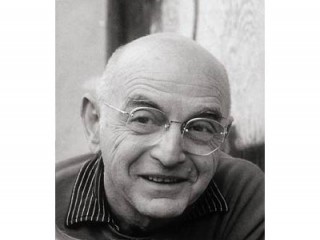
Henri Cartier-Bresson biography
Date of birth : 1908-08-22
Date of death : 2004-08-03
Birthplace : Chanteloup-en-Brie, France
Nationality : French
Category : Famous Figures
Last modified : 2011-09-27
Credited as : photographer, photojournalism, real life reportage
0 votes so far
Born in Paris in 1908, Cartier-Bresson grew up in a well-to-do but notoriously frugal household headed by a father who ran the family's successful textile business. After a strict Roman Catholic education, he rebelled against the bourgeois conventions of his upbringing, and duly took up the study of painting in Paris. There, in the late 1920s, he fell into Surrealist circles, and cultivated friendships with a number of cutting-edge artists and writers of the era. At England's Cambridge University, he took courses in literature and art, and did a tour of duty in the French Army in the early 1930s. Upon his discharge, he headed to Africa to hunt big game. There, he contracted a deadly fever, and sent his family a postcard with instructions for his funeral. "Your grandfather finds all that too expensive," was the reply, according to the New York Times ' Michael Kimmelman. "It would be preferable that you return first."
Cartier-Bresson made it back to France, and recuperated in the seaport city of Marseilles. There, he bought a small Leica, one of the first easily portable 35-millimeter cameras, and took his first photographs. From his Surrealist ties, he had come to understand the importance of spontaneity in art, and so he would wander the sometimes-dingy streets of Marseilles until he chanced upon the perfect scene to capture. His assured eye produced stunning images, and his work quickly gained renown across Europe thanks to gallery exhibitions. He also worked for Ce Soir, the French Communist newspaper. When World War II erupted, he served in a film unit of the French Army, but in June of 1940 was taken prisoner. Held for nearly three years, he escaped on his third attempt and joined the French Resistance.
After documenting the end of war in some famously compelling images, Cartier-Bresson went on to become one of the founders of the Magnum photo agency in 1947. Its photographers owned the rights to their photos, which was a novel idea at the time. Cartier-Bresson did not believe that a photograph should ever be cropped and asserted that any editing should be done just before, or as, the image was snapped.
Though his eye for composition was extraordinary, Cartier-Bresson preferred to describe the medium as the moment when the eye, the head, and the heart aligned. He traveled the world photographing events and their participants, or just ordinary individuals. Other photographers marveled at what seemed to be his extraordinary luck in getting a perfect, emotionally incisive shot, and Cartier-Bresson called this "the decisive moment," which was also the English-language title of his book, Images a la Sauvette. Once, his luck was tragic: he photographed Indian leader Mahatma Gandhi just 15 minutes before he was assassinated. He was granted a rare photographer's visa to visit the Soviet Union in the 1950s, and later photographed Cuba for a Life magazine photo essay.
Cartier-Bresson enjoyed a lengthy list of honors and retrospectives during his lifetime, but he left Magnum in 1966, and took up drawing again in his senior years. With his wife, the photographer Martine Franck, he established a foundation in Paris bearing his name, which opened in 2003. The New York Times ' Kimmelman called some of his early images "simply among the best works of 20th-century art," while Peter Conrad's tribute in the London Observer contained a meditation on the author's favorite Cartier-Bresson photograph-of a little boy returning from a Paris market. "He carries two bottles of wine, cradling them as if they were his fragile twin siblings," Conrad wrote. "He beams with delight, pleased to be charged with this delicate responsibility, even more pleased to be, while the photographer is looking at him, the centre of the world."
Cartier-Bresson's first marriage, in 1937 to a Javanese dancer named Ratna Mohini, ended after 30 years. He died on August 3, 2004, at his home in Lisle-sur-la-Sorgue, in southwest France. He is survived by his wife, Martine, and their daughter, Melanie. He was 95 years old, and had retained his characteristic wit and lively spirit until the end of his life. He often joked that he had no imagination, which was why he had failed at painting and abandoned a brief fling with filmmaking in the 1930s. Taking photographs, he countered, was much easier, and he was enchanted by the Buddhist teachings he read, one of which seemed to be the driving force behind the beauty and humanity of his images. It was the tenet that "life changes every minute," he once said, according to Andrew Robinson of the Guardian, and "the world is born and dies every minute."
















